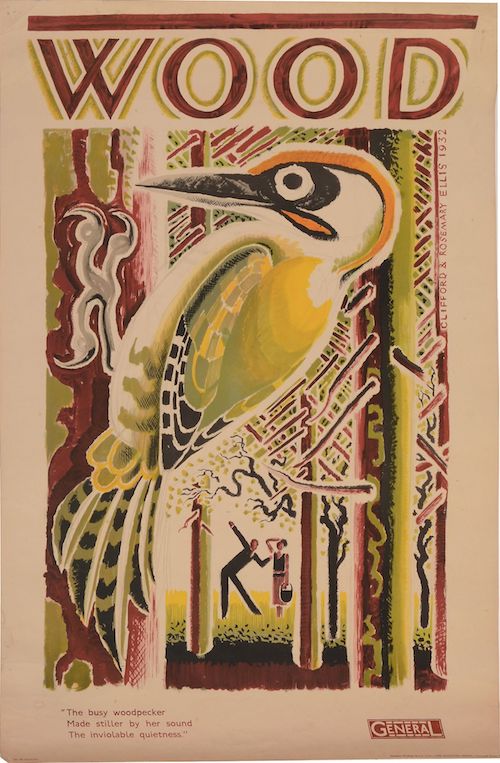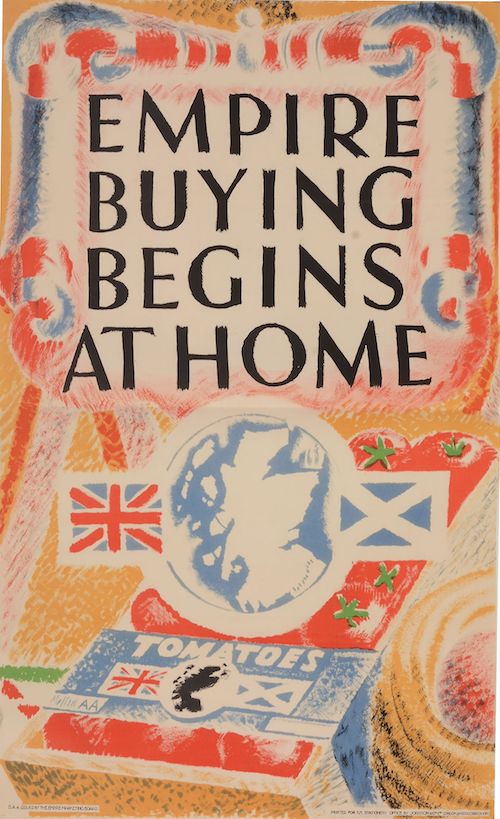I was going to try and say something clever about this auction that’s coming up at Bloomsbury/Dreweatts first thing tomorrow, but there isn’t really much point. Because what’s coming up – at least the interesting part of it – is a collection of posters designed by Clifford and Rosemary Ellis, and almost every single one of them is a gem.
One or two of their series of different bird habitats for London Transport appear relatively often at auction.
But this one is almost entirely new to me, and it’s the best one of all.
Of course this has the entirely predictable results that a) I want it and b) it’s too expensive to buy because everyone else is likely to feel the same.
Also for London Transport is this slightly odder image. I’m not entirely sure what it wants me to do, and I definitely don’t know where it’s suggesting I go. Except possibly mad.
Only slightly less peculiar is this variation on the ‘Shop Early’ posters which suggests that we should shop earlier in the month. Why? Can anyone explain?
Lovely though they are on their own, the LT posters are just a small slice of what’s on offer. You could, for example get yourself almost an entire set of Empire Marketing Board posters. Here are just two of the five, to give you the idea.
I have two things to say about these posters. One is that the latter one is described in the auction catalogue as ‘The Market Stall’ when it is clearly a County Show, and as these are some of my favourite things in the world I will not be gainsaid on that. Secondly, if you want more info about how the full set fitted together on a billboard, I’ve posted about it not once but twice; and if you’re worried about the ethics of Empire promotion – although these are fairly inoffensive examples – you can find my thoughts here.
That’s not the end of it either. The Ellises designed posters for Shell, and these are in the auction too.
Along with some more Shell posters.
Although just for a change there is a – rather wonderful – BP poster as well.
With a final garnish of GPO posters too, including this one.
Which I have been forced to mention in despatches before, on account of its slightly deranged title. Why indeed are we not on the telephone. Except we are.
Clearly I owe the Ellises a proper blog post of their own, and even more now that I have discovered – thanks to a newspaper article about this auction – that they came from Bath, just up the road from Crownfolio HQ. Here they are in Lansdown, being artists in 1937.
They’re sitting amongst their work for the British Pavilion at the 1937 Paris Exposition. I will come back to this, I promise.












That telephone poster reminds me of the 1934 GPO Film Unit short ‘Pett and Pott’, in which it is explicitly stated in the cast list that good people have telephones and evil people don’t.
What the unphoned couple have is a maid, employed by the wife when the husband suggested getting a phone.
Inevitably the maid turns out to be the leader of burglary gang, and the evil wife hides in her bedroom unable to call the police (should have got a phone, obviously). Very strange piece, which apparently annoyed people by not being much like a documentary.
I knew nothing of this at all, so thank you for conveying the utter bonkerness of this so concisely.
Even more joyously, the entire thing is available to view : https://vimeo.com/106694840. Have fun with that.
I saw it on ‘Addressing The Nation’, volume 1 of the BFI’s GPO Film Unit Collection (£1.00 from my local Cancer Research shop).
There’s another fascinating one on the same DVD. ‘The King’s Stamp’ is about the creation of a new stamp for George V’s Silver Jubilee and stars Barnett Freedman as himself.
Shop in the in the month OF DECEMBER! Avoid the Christmas rush! (Robins give the game away.)
Do you think “Down” “River” makes up for a pair poster? I *think* Christies thought so – or at least that it might have been.
http://www.christies.com/lotfinder/posters-signage-advertising/clifford-rosemary-ellis-down-5366184-details.aspx?from=searchresults&intObjectID=5366184&sid=14e673cf-18c4-42c2-a4ec-6a660c6b2fca
Anyway, Down is still for sale, probably yours for £600 plus extras. http://www.dreweatts.com/cms/pages/lot/14001/130
I am very envious of that charity shop bargain. Although I can also recommend the British Rail compilation DVD too.
And yes, of course, December. I should have looked more closely. Although the more I do that, the more I covet the posters and then it all gets a bit dodgy (we did end up buying one, and that’s entirely because I wrote this post).
All of which means I am not going to get Down, not unless someone posts it to me for about £50, which is about as likely as those two being a pair poster. The LTM site doesn’t reckon it is one either.
Hello crownfolio. I have posted a couple of comments elsewhere, before realising that the messages had been first posted up to 6 years ago(!) So, rather doubtful they will get picked up now. (My own post continues to display the message: “Your comment is awaiting moderation..!”)
I shall attempt to copy them across to here, in the unlikely event that they are still of any interest and/or relevance to anyone! (At the time, you were asking for further information about poster artists, from a list of several dozen names.)
Bertie D. Bassett
Post/1
Posted January 17, 2017 at 12:44 am | Permalink
Your comment is awaiting moderation.
Hello Crownfolio. My name is Derek (Bertie) Bassett. I was a student at Guildford School of Art 1958-1962, when Alan Coleman was Principal. I was interviewed for admission by Len Stoppani, and still have the letter of acceptance signed by him.
I’m pleased to be able to give some information on two of the names in your list above. I hope it may be of some interest.
G.B.KARO. George Karo (Polish name Jerzy Brezinski, but I’m not sure of the correct Polish spelling of his surname.) As a young man, George fled Poland in the wake of the invasion, at the start of WWII. During the escape to Gt. Britain, he tragically lost both his parents.
George was a brilliant graphic artist, and a tremendous inspiration as a lecturer during my time under his guidance, 1960-1962. He shepherded a small group of students specialising in poster , record sleeve, book jacket, and industrial design, as well as news print advertisements for A-list clients.
For quite some time after leaving Guildford School of Art, I continued to see George and his wife, at their home in Balham. I was working as an advertising studio artist in Carshalton at the time, but following a job change, I moved away from my flat in S.Croydon. Rather sadly, I never quite managed to create the opportunity of meeting up with them again.
VERNON SURRIDGE was a graphic and typographic design lecturer, specialising mainly in the many aspects of press advertising. I was a student in his class during 1959/60. He was also well known for his interest in space exploration, at the height of the successful Russian Sputnik experiment. He is also remembered for his tale about applying for a job. A requirement in the advertisement stated that:- “only the cream need apply”. V.S. sent off his application in the post, and included a carton of cream. He apparently landed the job!
I have just read about student unrest at Guildford.. At the end of my Preliminary Year in 1959, the Student Union was involved in a petition to have Alan Coleman ‘removed’ as Principal. He had only recently been appointed to replace Dudley Holland, but clearly, he was not as well liked as his predecessor. However, the endeavour failed to achieve its aim, and the still incumbent Coleman never forgave those who had lent their name to the document requesting his removal.
My memory is now beginning to fade, but if there is anything else you think I may be able to help you with, then by all means, kindly do email me. Bertie.B.
POST/2 (Edited)
Bertie D. Bassett
Posted January 19, 2017 at 9:04 am | Permalink
Your comment is awaiting moderation.
I would like to offer a simple explanation, in reply to crownfolio’s comments, (both here and elsewhere) relating to the GPO Telephones ‘Reflections’ poster. I am entirely guessing, but suspect that the ‘Reflections’ poster is Pre-war, and possibly late 1920’s, early 1930’s?
Its relevance is actually quite straightforward, and not at all ‘bonkers’, once you are aware of the prevailing social and economic circumstances at that particular point in history! Its sole purpose would have been to entice new subscribers, at a time when the vast majority of the population were most definitely NOT connected ‘on the telephone’!
A decade or so later, and despite post-war austerity, the increase in potential subscribers in the 40’s and 50’s began to out-strip the G.P.O’s ability to supply a private telephone line.
There was a considerably long waiting list, and most new subscribers had to be content with sharing the service with another subscriber on a ‘party line’. With hindsight, this was a highly unsatisfactory arrangement.
If subscriber A lifted the receiver to initiate a call, but subscriber B was already using the line, the fact that caller B was connected via the Exchange, did not automatically send a ‘line engaged’ signal to caller A! As a result, caller B’s entire two-way conversation could be overheard by caller A, unless, or until, the handset was replaced on the cradle! (And vice-versa, of course) So the service was far from private, and was open to eavesdropping. It relied solely upon the discretion – or otherwise – of both parties involved!
Which leads nicely into the other GPO poster, showing workmen digging a trench, prior to laying the pipeline which was used to carry the telephone cables underground, in urban areas.
It seems most likely that the original intention of this poster was to illustrate the complex work involved in extending the telephone service. No doubt the GPO had high hopes that this image might quell some of the strong feelings from all those vexed, would-be private-line subscribers, who were still on the waiting list!
It probably sought to avoid further criticism, by graphically portraying the considerable difficulty the GPO was facing, in order to provide sufficient cable capacity for new customers. There was also the pressing problem of upgrading existing party line subscribers to private line.
The whole scenario was eerily similar to the current problem relating to the lengthy delay of introducing super-fast broadband in some areas.
I am assuming that the ‘Workmen’ poster does post-date the the ‘Reflections’ poster. If that is indeed the case, then it could lead one to assume that, far from not making any sense, it might have been a remarkably successful advertising campaign. After all, it may have been responsible for attracting new business well beyond the GPO’s immediate capacity to provide a satisfactory service!
It would be interesting to discover the respective launch dates of the two posters concerned?
Bertie.
(Guildford School of Art, Graphic Design, 1958-1962)
Hello, and thanks for the comments. I’ve now replied on the relevant pages as my answers are probably more use there. I do see all comments, it’s just a question of finding the time to reply properly!